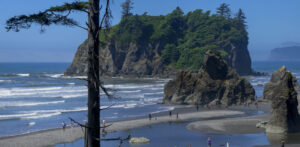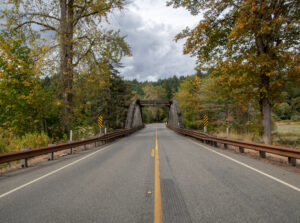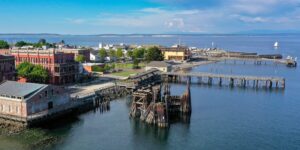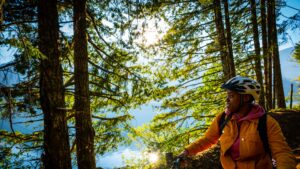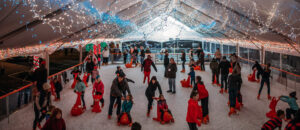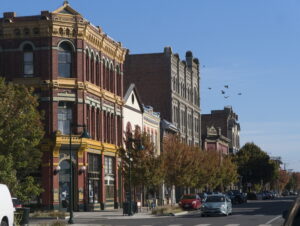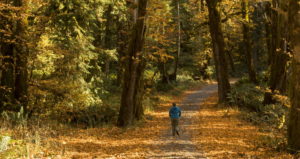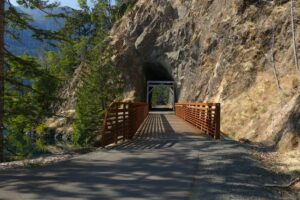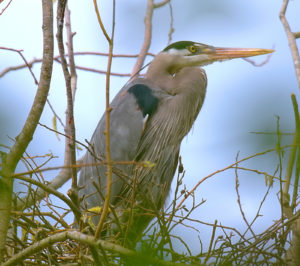
A blue heron in its nest
The Perfect Time for Birding on the Olympic Peninsula
There is a whole amazing world of wildlife out there, it’s happening right now, it’s happening all around you, and it’s worth tuning in.
While our human world has slowed down the last two years, birds are a reminder that nature never stops. If you are looking for a new hobby, or a new way to view the world around you, now is the perfect time to begin birding on the Olympic Peninsula.
Why Birding?
Birds are everywhere! You don’t have to travel far, or at all, to find them. There are certain birds more likely to only be found in wild places, and other birds who cohabitate our cities, towns, suburbs and parking lots. Looking for birds is a game you can always play.
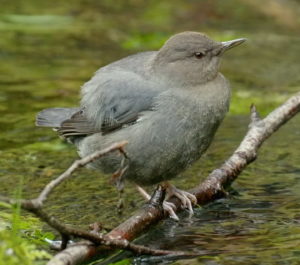
An American Dipper in the Hoh River
Birds are indicators of what is going on in our environment. Birds can tell us a lot about our world, we just have to learn how to listen to what they are saying. Different birds have different habitat requirements. For example, American Dippers (Cinclus mexicanus) need clean, fast moving rivers and streams. The presence of American Dippers is an indicator of good water quality.
Not to mention, birding is simply a good reason to go play outside! And you never know what you are going to find.
The Olympic Peninsula is a Phenomenal Place for Birding
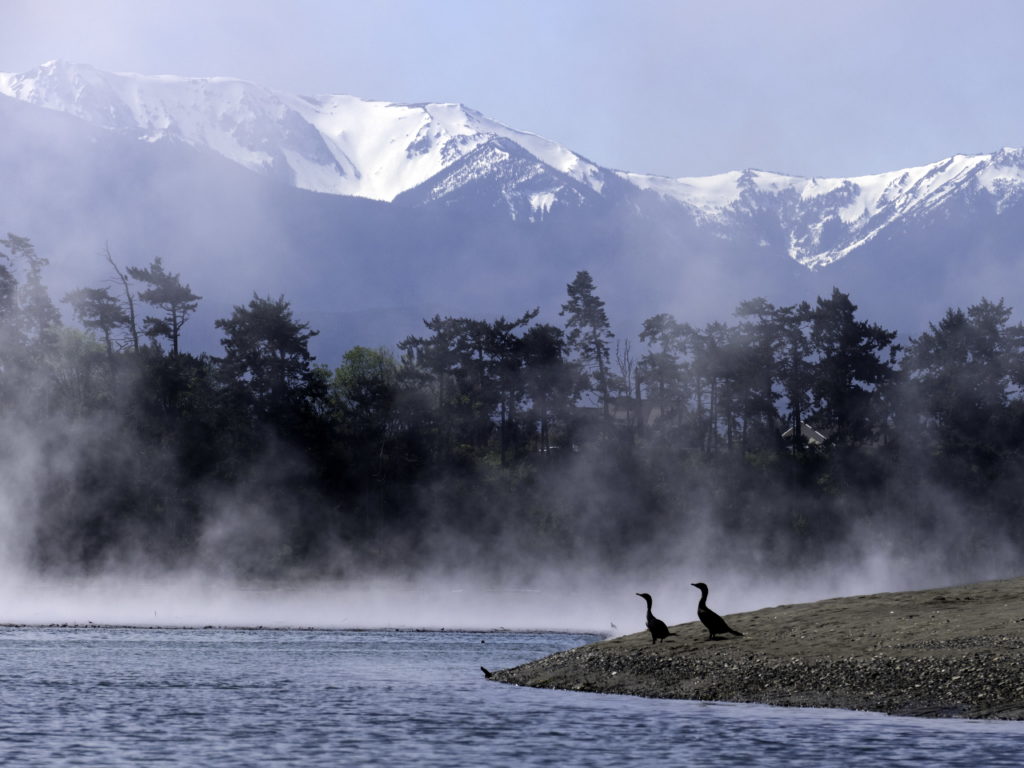
Cormorants at Dungeness Bay near Sequim
Because of a wide range of precipitation and elevation, salt and fresh water, forest, prairie and rock, the Olympic Peninsula has a multitude of different habitats and supports incredible biodiversity.
Our position along the 48th parallel, is a perfect mid-point to host waterfowl that migrate south from Alaska and Canada for the winter, and songbirds that fly north from Central America for the summer.
The Olympic Peninsula is also along the Pacific Flyway, a flight path used by large numbers of birds migrating between their breeding and wintering grounds.
April and May are the Height of Migration
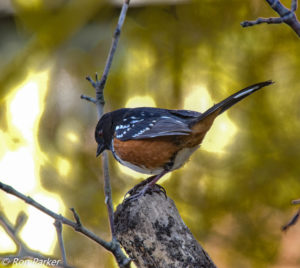
A towhee at the Dungeness River Audubon Center. Photo by Ron Parker
We start to see the departure of many of our seabird species that we saw along the Strait all winter like Surf Scoter, Bufflehead, Common Loon, Horned Grebe, and many more. These species spend winter here taking advantage of our mild ocean temperatures (for a bird!) before heading north to breed.
We also begin to welcome songbirds coming up from the south to utilize our lush forests and take advantage of the new spring growth, species like Wilson’s Warbler, Black-throated Gray Warbler, Swainson’s Thrush, Western Wood-Pewee, etc…the list goes on and on!
Resident Birds on the Olympic Peninsula
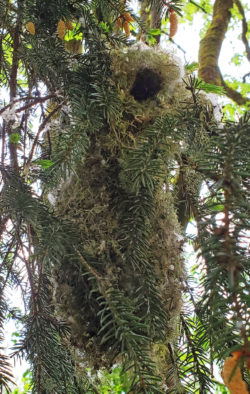
Bushtit nest made from moss and lichen
While this is a very exciting time of year to witness the migrations happening all around us, let’s not forget about our resident birds!
There are many birds that stick around this area all year round, some of our backyard favorites like Chestnut-backed Chickadees, Black-capped Chickadees, Song Sparrows, House Finches, Pacific Wrens, Dark-eyed Juncos and more.
Aside from saving energy by not having to migrate, another advantage for the resident birds is they get first dibs on nesting spots and start laying eggs before many of the migratory species even get here. They can take advantage of the resources available in early spring and get things started prior to the increase of competition to be expected later in the season.
Many of these birds are building nests and mating right now, making this time of year an especially fun time to tune into the world of birds!
How to Get Started

Birding in the Dungeness Valley
While you don’t need any tools to appreciate birds, having a field guide and some binoculars can help you figure out what you are looking at and enhance your appreciation. Visit Audubon.org to use the online Bird Guide as well as tips for identifying birds.
When trying to identify a new bird, here are a few questions to ask….
How big is it? (Compare it to a bird you already know. Bigger or smaller than a Robin?)
Where was it seen? (Both geographically and what habitat?)
What is the behavior of the bird? Is it doing anything unique or unusual? How is it feeding? Flight pattern?
Flock or no Flock? (Certain species are mostly found in groups, and some more solitary)
What are its’ tools? Specifically, feet and beaks can give in-site to what bird it is and how it survives.
Birding Close to Home
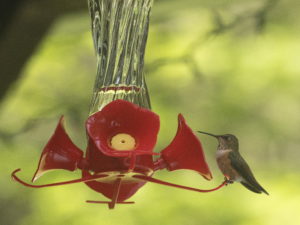
Rufous hummingbird resting at a feeder
You can explore your neighborhood, hit the trails (when they are open), or just enjoy birdwatching in your own backyard. The most important part of making your yard a more bird-friendly place, is planting native plants. The most suitable diet for birds that live on the Olympic Peninsula comes from the plants that are from here. The National Wildlife Federation has resources for growing native plant gardens.
For your own viewing pleasure, and to provide an extra protein boost, you can also hang bird feeders. This is a great way to see the birds up close, and get to know some of your backyard locals better.
The Dungeness River Audubon Center offers numerous classes and field-trips aimed at connecting people to the natural world. All events are currently on hold, but if you would like to stay connected with us and receive our newsletters, please email jenna@dungenessrivercenter.org.
World Migratory Bird Day takes place in May
World Migratory Bird Day always takes place on the second Saturday in May. For 2022, the World Migratory Bird Day theme is “The Impact of Light Pollution on Migratory Birds“. The pathways of migratory birds transcend national border and connect countries. Try to connect and get to know the birds around you during spring. Their conservation plans require cooperation between countries and remind us of that we are all connected.
Written by guest blogger Jenna Ziogas, Education Coordinator of the Dungeness River Audubon Center

